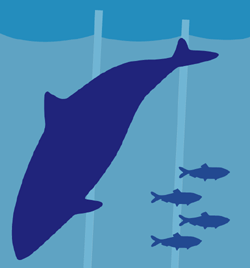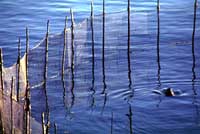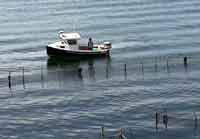|
Harbour
Porpoise Release Program
 Begun
in 1991, the Harbour Porpoise Release Program was developed by the Grand
Manan Whale & Seabird Research Station to assist herring weir operators
safely remove harbour porpoises from their weir
without loosing the trapped herring. Porpoises swim into herring weirs
during the night but most do not swim out again. While they are inside
the weirs they are able to swim, breathe and eat. We work with weir operators
and remove the porpoise(s) from the weir in our small boats, allowing the
weir operators to harvest their herring catch. Begun
in 1991, the Harbour Porpoise Release Program was developed by the Grand
Manan Whale & Seabird Research Station to assist herring weir operators
safely remove harbour porpoises from their weir
without loosing the trapped herring. Porpoises swim into herring weirs
during the night but most do not swim out again. While they are inside
the weirs they are able to swim, breathe and eat. We work with weir operators
and remove the porpoise(s) from the weir in our small boats, allowing the
weir operators to harvest their herring catch.
 Newsletter
Archives: Newsletter
Archives:

Harbour
Porpoises & Weirs:
The
Nature of the Interaction
The
Weir Fishery
Weir
fishing in the Bay of Fundy dates back to before European settlers arrived
in North Amerca. Local bands of indigenous Canadians (Passamaquody and
Mik'maq peoples) used weirs to catch fish for subsistence. Today, the weir
fishery is a commercial industry, providing herring for a variety of purposes
including cans of "sardines" produced locally and in other places. Chances
are that if you live in North America and eat sardines, those fish probably
came from the Bay of Fundy, and possibly from a weir on Grand Manan!
What
is a Weir?
A
weir is heart or kidney shaped structure built from stakes and twine net
that acts to catch and concentrate fish as they move laterally along a
shoreline. Fish swimming along the shore first encounter a net running
perpendicular to the shoreline and alter their course to swim along it.
This "fence" directs the fish into the mouth of the weir where they swim
across the weir and encounter the back twine. At this point the fish again
alter their course and swim along the net. The curved shape of the weir
continually directs fish away from the mouth, keeping the them from escaping.
When full of fish, the mouth of a weir is often shut off with another net
to ensure that the fish don't escape!
Porpoises
and Weirs
Although
porpoises eat many different species, they feed primarily on herring in
the Bay of Fundy. Weirs tend to catch the majority of their herring at
night, as they move along the shoreline in relatively shallow waters. Porpoises
often follow these shoals of herring into weirs and become entrapped. Sometimes
they swim out, but in the majority of cases thay have difficulty finding
the mouth of the weir and escaping. This is especially true if the weir
is shut off.
Weir
Check
 Every
morning staff members of the GMWSRS check the local weirs for porpoises.
This is usually done in a small boat. After approaching a weir the boat
is stopped and the weir is scanned for a minimum of 5 minutes - that's
about the longest that a porpoise could remain submerged without surfacing
to breathe. When the weir checkers are certain that there are no porpoises
in the weir, they move on to the next one! Every
morning staff members of the GMWSRS check the local weirs for porpoises.
This is usually done in a small boat. After approaching a weir the boat
is stopped and the weir is scanned for a minimum of 5 minutes - that's
about the longest that a porpoise could remain submerged without surfacing
to breathe. When the weir checkers are certain that there are no porpoises
in the weir, they move on to the next one!
Safe
Release:
Removing
porpoise from weirs safely.
Development
of the Program
Since
1991 the GMWSRS has worked with local weir operators to develop safe methods
of removing porpoises from weirs. These methods help conserve porpoises
and help scientists learn more about this threatened species - all without
compromising herring catches! Weir operators receive a small level of compensation
to help pay for fuel and crew costs incurred during the process!
Overview
of the Release Process
When
a porpoise (or porpoises) is reported in a weir, the first step is to contact
the owner/operator of the weir and organize when to help get them out.
In many cases this occurs when the herring in the weir are sold for market.
This process is called a seine, or seining a weir. The seine process begins
with fishers deploying their net (also called a seine) around the inside
perimeter of the weir. They go slowly but steadlily to keep the fish in
the middle of the net. When they've gone completely around the inside of
the weir the ends of the seine are brought together and the bottom of the
seine is closed, or "pursed." Now the herring are trapped inside and the
net is slowly pulled onboard to concentrate the fish at the surface. A
special boat called a herring pumper then pumps the concentrated fish from
the siene into a carrier boat which then transports the fish to market.

During
this process GMWSRS staff are working to release the porpoise(s). Several
staff members will bring a small boat into the weir along side the seine.
Depending on the number of porpoises in the weir, one or two divers with
snorkels enter the water at the perimeter of the seine. They scan the water
and the net looking for the porpoise(s). As the net comes up their job
is to bring the animals to the surface and over to the small boat. After
the diver hands the porpoise up to the biologists in the boat, the porpoise(s)
are gently layed on a soft foam mat and the boat is driven into open water
clear of the weir. Porpoises are released a distance from the weir to reduce
the chances of them swimming straight back in by mistake.
Outreach
With
the help of our sponsers, the GMWSRS produced a manual detailing the our
methods for safely romoving porpoises from weirs. A waterproof flashcard
was distributed along with the manual, to help remind people of the methods
during a release! The manual and card were aimed at teaching weir operators
and community groups in areas other than Grand Manan how to remove porpoises
from weirs safely. Both are available in PDF format for download:
To
download the Bulletin No. 3 or the Flashcard you must have Acrobat
Reader. If you do not have this program click below to download it.
The
Mammal Seine: Designing and Producing a Safer Net
Sometimes
it is important to remove porpoises from weirs before they are seined for
fish. To accomplish this, a special mammal seine was developed by the GMWSRS
with the help of local fishers. This special net has a larger diameter
mesh that allows the fish to swim though but keeps the porpoise in . The
net itself is also more bouyant in the water - making it float up to help
divers catch the porpoise - and is light green in colour, making it easier
to spot and scan by the diver.
More
about harbour porpoises. |

![]()

![]()


